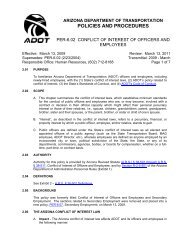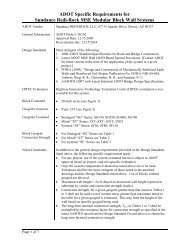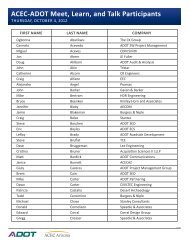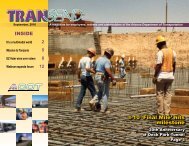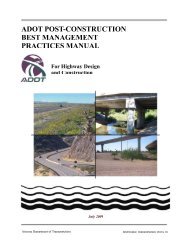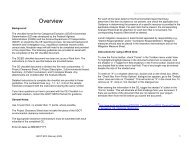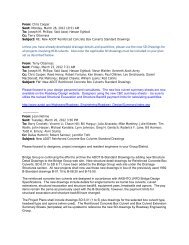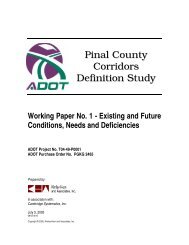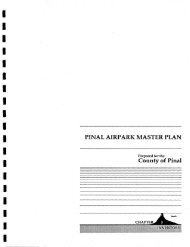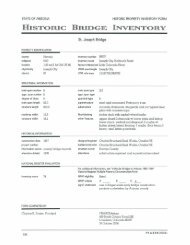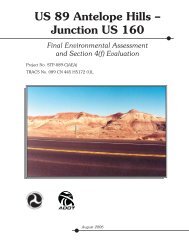I-10 Twin Peaks Traffic Interchange, Environmental Assessment
I-10 Twin Peaks Traffic Interchange, Environmental Assessment
I-10 Twin Peaks Traffic Interchange, Environmental Assessment
Create successful ePaper yourself
Turn your PDF publications into a flip-book with our unique Google optimized e-Paper software.
Affected Environment and <strong>Environmental</strong> Impacts October 2005<br />
Conclusion<br />
As a result of these mitigation measures, the proposed project would have only<br />
temporary, short-term, and minimal impacts to particulate levels during project<br />
construction. The project would decrease traffic congestion in the study area,<br />
which would improve overall air quality. Pedestrian and bicycle facility<br />
connectivity within the area would be improved; therefore, an increased use of less<br />
polluting alternative transportation modes would be expected.<br />
Noise<br />
ADOT’s Noise Abatement Policy(NAP) for Federal Aid Projects (March 21, 2000)<br />
defines a traffic noise impact as:<br />
• When the predicted level approaches or exceeds the FHWA’s NAC. ADOT<br />
defines “approach” as being within 3 dBA of the appropriate NAC. Under<br />
this policy, residential impacts would occur when the future Leq(h) value is<br />
64 dBA or greater; or,<br />
• When the predicted level substantially increases over existing noise levels.<br />
“Substantial” is defined as an increase of 15 dBA or higher.<br />
Existing Conditions<br />
The complete results of the traffic noise analyses are presented in the document<br />
Interstate <strong>10</strong> <strong>Traffic</strong> <strong>Interchange</strong> at <strong>Twin</strong> <strong>Peaks</strong>/Linda Vista Final <strong>Traffic</strong> Noise<br />
Analysis Report, dated September, 2004. Readers are referred to this report for the<br />
detailed findings; however, the results are summarized below.<br />
<strong>Traffic</strong> Noise Monitoring<br />
Existing traffic noise conditions were assessed using traffic noise monitoring.<br />
Field monitoring of traffic noise during peak traffic periods was conducted on<br />
December 4, December 16, and December 17, 2003. Monitoring occurred between<br />
approximately 7:00 AM and 8:00 AM and between 4:00 PM and 6:00 PM. Noise<br />
levels were measured at seven locations near roadways in the study area using an<br />
integrating sound level meter.<br />
The field monitoring results are presented in Table 4-7. Measured noise levels<br />
ranged from 55 dBA near <strong>Twin</strong> <strong>Peaks</strong> Elementary School to 73 dBA west of the I-<br />
<strong>10</strong> Frontage Road at Linda Vista Boulevard. As expected, the highest noise<br />
readings were near I-<strong>10</strong>.<br />
<strong>Traffic</strong> Noise Modeling<br />
Computer modeling of traffic noise can be utilized at a greater number of locations<br />
along a corridor than noise monitoring, modeling can be adjusted to replicate<br />
highest traffic volumes and other parameters, and modeling can be used to assist in<br />
traffic noise mitigation design. For these reasons, noise impacts resulting from<br />
existing roadway traffic were analyzed using STAMINA/Optima 2.0 (STAMINA).<br />
Interstate <strong>10</strong> <strong>Traffic</strong> <strong>Interchange</strong> at<br />
<strong>Twin</strong> <strong>Peaks</strong>/Linda Vista<br />
4-49<br />
Project No.: NH-0<strong>10</strong>-D (AIW)<br />
TRACS No.: <strong>10</strong> PM 236 H5838 01D



